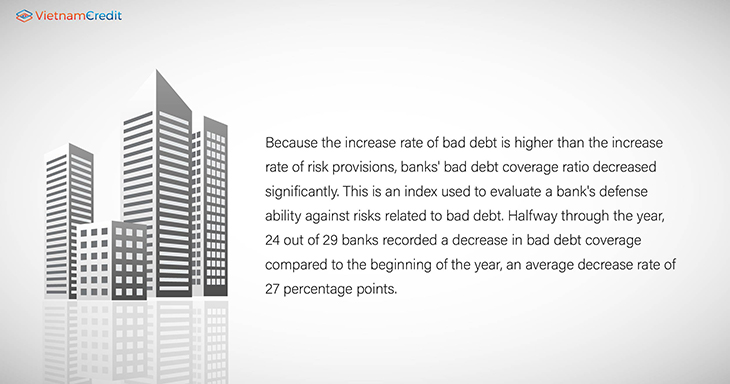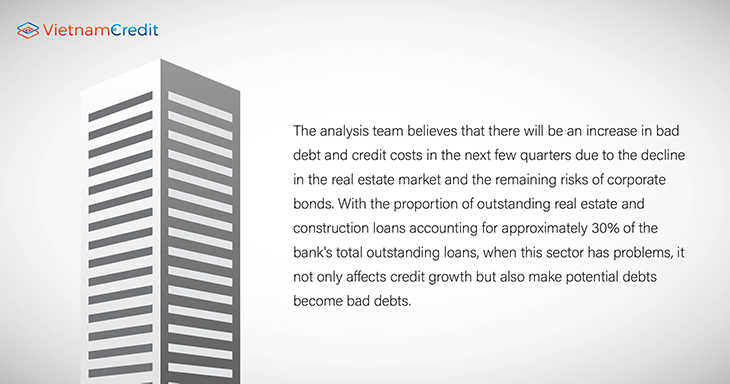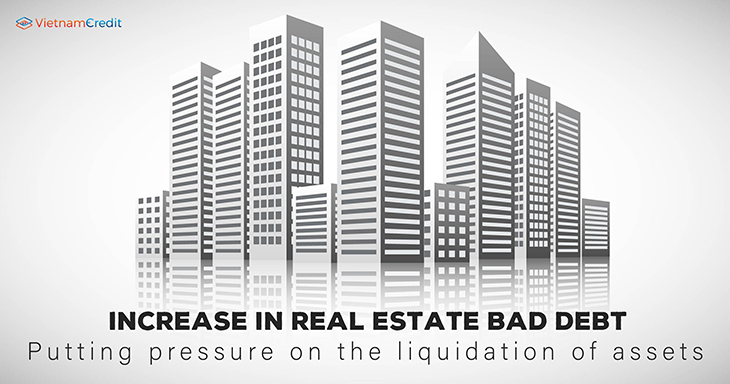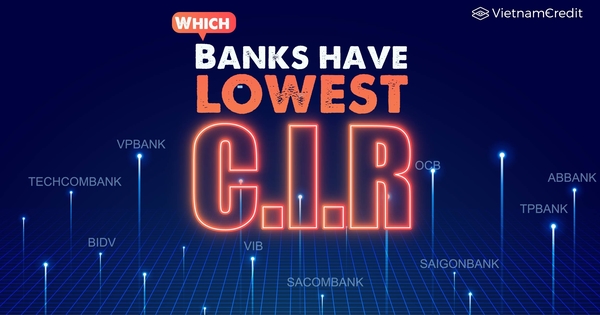The State Bank of Vietnam (SBV) has begun to warn about the increase in real estate bad debt through specific figures. Although commercial banks have increased their capital buffers, they still seem concerned with the downtrend of the real estate market and risks from bond market. Therefore, they have accelerated the liquidation of collateral assets. However, selling assets is no longer as favorable as before.
According to data from 29 banks that have published semi-annual financial reports, the total bad debt is VND 219,747 billion, an increase of 34% compared to the beginning of this year. Meanwhile, provision for loans to customers only increased by 10%, at VND 225,327 billion.

Because the increase rate of bad debt is higher than the increase rate of risk provisions, banks' bad debt coverage ratio decreased significantly. This is an index used to evaluate a bank's defense ability against risks related to bad debt. Halfway through the year, 24 out of 29 banks recorded a decrease in bad debt coverage compared to the beginning of the year, an average decrease rate of 27 percentage points.
MB is the bank with the strongest decrease from 238% to 156.1% (82 percentage points), followed by TPB decreasing from 135.1% to 60.9% (74 percentage points), BIDV from 216, 9% to 152.6% (down 64 percentage points). Only 5 banks had their bad debt coverage ratio increased including Vietcombank Kien Long Bank, SHB, BaoVietBank and Vietbank.
Provisioning helps banks partly cope with risks but at the same time affects profits. Therefore, each bank has tried to keep the bad debt coverage ratio at a reasonable level to both prevent bad debts and ensure profits for itself.
If the bad debt coverage ratio at most banks remains above 100%, it shows that banks have made enough provisions. In the worst case, if transferred to the group of irrecoverable bad debts, the bank still has provisions to cover this debt without affecting profits.
At the end of last year, the top 10 banks with the highest bad debt coverage ratio all exceeded 100%. However, through the first half of this year, the last two positions in the top 10, SeABank and LPBank, no longer achieved a coverage rate of over 100%.
Although bad debt is currently being supported by policies to help recover the economy, the data still shows that bad debt is growing beyond the threshold. In particular, real estate is being warned as the most potentially risky field when the market weakens, causing debts to be grouped as the worst debt.
Information at a recent conference on capital for businesses, Ms. Ha Thu Giang, Director of the Department of Credit for Economic Sectors (SBV), said that the bad debt ratio of the real estate sector is on the rise. In June 2022, the bad debt ratio of this sector was 1.53%, while in the first half of this year it nearly doubled, to 2.47%.
Currently, real estate businesses are receiving a lot of support from Circular 02/2023 of the State Bank, allowing credit institutions to proactively restructure debt repayment terms and keep the debt group intact when certain conditions are met within 1 year from the date of restructuring.
Therefore, when the circular expires, bad debt will certainly increase. In case banks do not reschedule debts, debt group jumping will happen very quickly and the bad debt situation will worsen very fast compared to the currently announced figures.
The report of Rong Viet Securities Company also stated that in 2023, the banking industry will continue to be in the downward real estate cycle. However, the resilience of each bank will depend on the quality of assets and its level of prudence over the years.

The analysis team believes that there will be an increase in bad debt and credit costs in the next few quarters due to the decline in the real estate market and the remaining risks of corporate bonds. With the proportion of outstanding real estate and construction loans accounting for approximately 30% of the bank's total outstanding loans, when this sector has problems, it not only affects credit growth but also make potential debts become bad debts.
Pressure to liquidate collateral assets increases
According to many experts, the banking system's bad debts may peak at the end of 2023 or early 2024. Banks are actively selling bad debts with collateral worth up to thousands of billions of dong to relieve the pressure. However, asset trading activities are no longer as favorable as before due to the difficult real estate market and mortgaged assets at banks are mainly land use rights, resort hotels, or factories.
Recently, many banks, including "giants" such as VietinBank, Vietcombank, and Agribank, have announced the sale of trillions of VND in debt from resort, hotel, and real estate projects around the country.

In particular, VietinBank has just announced for sale Area A of the Royal Marina Center Project with an area of nearly 6,000 m2; VietinBank sells nearly 60 hotels and real estate in Hoi An. The popular segment is 3-4-star hotels, homestays and villas with prices ranging from a few dozen to several hundred billion VND. In particular, there are two 4-star hotels with 98-104 rooms that are offered by VietinBank for the same price of VND 420 billion for each property.
Similarly, Agribank announced the sale of debts of 7 businesses, the total outstanding debt reached nearly VND 500 billion. These debts were mortgaged by land lots at the Thien Bao Phu Quoc Tourist Area and Hoang Hai Tourist Complex projects (Phu Quoc).
Meanwhile, BIDV regularly announces debt sales and asset auctions, but many have been auctioned several times without any buyers. Some companies' debts reach hundreds of billions of VND, such as debt from Phu Minh Son Group Joint Stock Company and Thanh Tam Joint Stock Company, with a starting price of more than VND 346 billion. Total outstanding principal and interest as of March 2023 is up to VND 582 billion.
Regarding banks' aggressive liquidation of real estate collateral, many experts assess that it is quite difficult as the bad debt trading market in Vietnam has not yet been shaped and has many limitations.
The research team from financial consulting unit AFA Capital said that in the draft revised law on credit institutions, bad debt trading prices need to be consistent with market prices. However, in reality, Vietnam currently does not have a bad debt trading market.
In addition, the sale of collateral assets, especially large debts, needs to be conducted at market prices, which is very difficult to do in a frozen real estate market situation. Furthermore, there are still many problems in the handling of collateral and debt recovery, including inconsistencies in the legal framework for the debt handling process, and there is no synchronization and consistency in implementation methods.
Many experts predict that in the coming time, the bad debt ratio will tend to increase because businesses related to the real estate sector and the corporate bond market are facing many difficulties. Although lending interest rates have decreased, they are still high, causing many companies to decline in production and business activities, giving rise to new bad debts.
Source: thesaigontimes
Compiled by VietnamCredit


























































